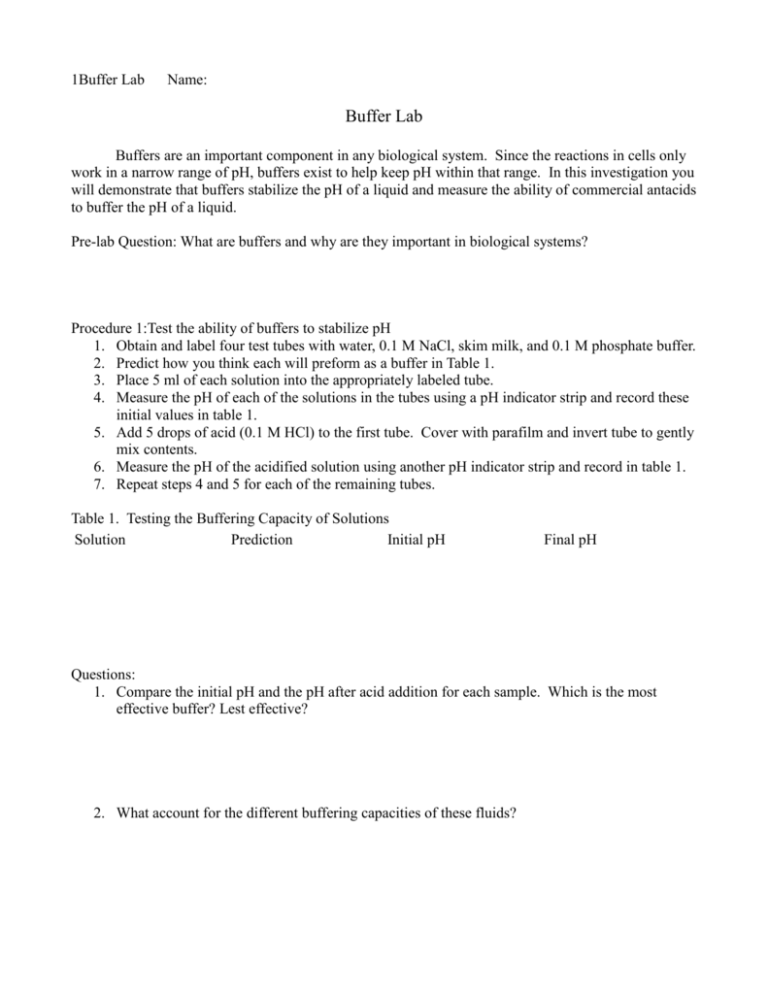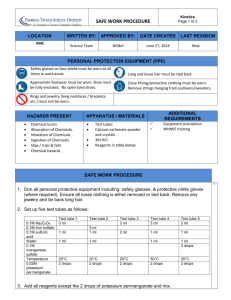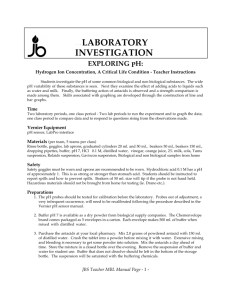Buffer Lab
advertisement

1Buffer Lab Name: Buffer Lab Buffers are an important component in any biological system. Since the reactions in cells only work in a narrow range of pH, buffers exist to help keep pH within that range. In this investigation you will demonstrate that buffers stabilize the pH of a liquid and measure the ability of commercial antacids to buffer the pH of a liquid. Pre-lab Question: What are buffers and why are they important in biological systems? Procedure 1:Test the ability of buffers to stabilize pH 1. Obtain and label four test tubes with water, 0.1 M NaCl, skim milk, and 0.1 M phosphate buffer. 2. Predict how you think each will preform as a buffer in Table 1. 3. Place 5 ml of each solution into the appropriately labeled tube. 4. Measure the pH of each of the solutions in the tubes using a pH indicator strip and record these initial values in table 1. 5. Add 5 drops of acid (0.1 M HCl) to the first tube. Cover with parafilm and invert tube to gently mix contents. 6. Measure the pH of the acidified solution using another pH indicator strip and record in table 1. 7. Repeat steps 4 and 5 for each of the remaining tubes. Table 1. Testing the Buffering Capacity of Solutions Solution Prediction Initial pH Final pH Questions: 1. Compare the initial pH and the pH after acid addition for each sample. Which is the most effective buffer? Lest effective? 2. What account for the different buffering capacities of these fluids? 2Buffer Lab Name: 3. What is the biological importance of what you observed? Procedure 2: Test the effectiveness of commercial antacids Commercial antacids such as Baking Soda, Alka-Seltzer, Rolaids, and Tums claim to neutralize stomach acid by absorbing excess H+ (produced as hydrochloric by the stomach). 1. Predict which antacid will do the best job in Table 2. 2. Using a pipet add 5 ml of the antacid solution into a test tube. Add 4 drops of Bogen’s Universal Indicator to the test tube. Cover the tube with parafilm and invert the tube to mix the contents. 3. Add 0.1 M hydrochloric acid (HCl) drop-wise to the tube: mix after each drop. Continue this process until the solution turns yellow, indicating an acidic solution. 4. Record the number of drops in table 2. This number of drops is an index to the amount of acid that the solution neutralizes before the pH drops below the yellow end point of Bogen’s Universal Indicator (pH 6). Table 2. Testing the Buffering Capacity of Antacids Solution Prediction Drops of Acid Questions: 1. Which antacid neutralizes the most acid? Which neutralizes the least acid? 2. What is the effect of dose (size of tablets) on your results and conclusions? 3. Your stomach secretes hydrochloric acid. Explain how would antacids 'settle an upset stomach.”








